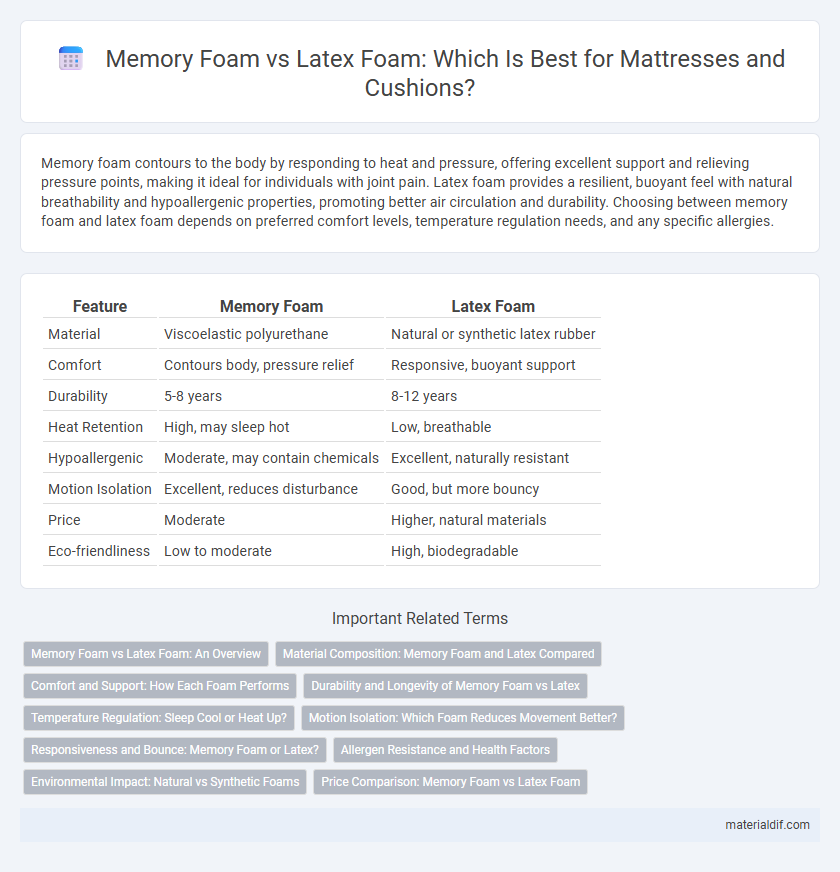Memory foam contours to the body by responding to heat and pressure, offering excellent support and relieving pressure points, making it ideal for individuals with joint pain. Latex foam provides a resilient, buoyant feel with natural breathability and hypoallergenic properties, promoting better air circulation and durability. Choosing between memory foam and latex foam depends on preferred comfort levels, temperature regulation needs, and any specific allergies.
Table of Comparison
| Feature | Memory Foam | Latex Foam |
|---|---|---|
| Material | Viscoelastic polyurethane | Natural or synthetic latex rubber |
| Comfort | Contours body, pressure relief | Responsive, buoyant support |
| Durability | 5-8 years | 8-12 years |
| Heat Retention | High, may sleep hot | Low, breathable |
| Hypoallergenic | Moderate, may contain chemicals | Excellent, naturally resistant |
| Motion Isolation | Excellent, reduces disturbance | Good, but more bouncy |
| Price | Moderate | Higher, natural materials |
| Eco-friendliness | Low to moderate | High, biodegradable |
Memory Foam vs Latex Foam: An Overview
Memory foam offers superior contouring and pressure relief by responding to body heat and weight, making it ideal for individuals with joint pain or those seeking personalized support. Latex foam provides enhanced durability, natural breathability, and hypoallergenic properties, appealing to eco-conscious consumers and those with allergies. Understanding the distinct benefits and material compositions helps in choosing between memory foam's adaptive comfort and latex foam's resilient and breathable structure.
Material Composition: Memory Foam and Latex Compared
Memory foam is primarily made from viscoelastic polyurethane, combining polyurethane with additional chemicals to increase density and viscosity, offering contouring and pressure relief properties. Latex foam is derived either naturally from rubber tree sap or synthesized from petrochemicals, providing a resilient, bouncy feel with excellent durability and breathability. The chemical composition differences directly influence the foams' performance, elasticity, temperature sensitivity, and hypoallergenic characteristics.
Comfort and Support: How Each Foam Performs
Memory foam contours to the body by responding to heat and pressure, providing personalized comfort and excellent pressure relief that reduces pain points. Latex foam offers a resilient, buoyant support with natural bounce, promoting proper spinal alignment and enhanced airflow for a cooler sleep experience. Both foams deliver superior comfort and support, with memory foam excelling in contouring and pressure distribution, while latex foam stands out in durability and responsive support.
Durability and Longevity of Memory Foam vs Latex
Memory foam offers excellent durability with a typical lifespan of 7 to 10 years, maintaining its shape and support over time due to its viscoelastic properties. Latex foam, particularly natural latex, often surpasses memory foam in longevity, lasting up to 12 to 15 years because of its resilient, buoyant structure and resistance to sagging. The superior durability of latex foam makes it a preferred choice for long-term use, while memory foam provides consistent pressure relief and contouring for around a decade.
Temperature Regulation: Sleep Cool or Heat Up?
Memory foam tends to retain body heat due to its dense structure, often causing sleepers to feel warmer throughout the night. Latex foam features an open-cell design and natural ventilation, promoting better airflow and enhancing temperature regulation for a cooler sleep experience. Choosing latex foam is generally more effective for individuals seeking consistent breathability and reduced heat buildup during sleep.
Motion Isolation: Which Foam Reduces Movement Better?
Memory foam excels in motion isolation by absorbing and contouring to body movements, minimizing transfer across the mattress surface. Latex foam offers a more responsive feel but tends to transmit motion more readily due to its buoyant and resilient structure. For sleepers seeking superior reduction of partner disturbance, memory foam mattresses generally outperform latex in isolating motion effectively.
Responsiveness and Bounce: Memory Foam or Latex?
Latex foam offers superior responsiveness and bounce due to its natural elasticity, quickly returning to its original shape after pressure is released. Memory foam contours slowly and absorbs energy, resulting in minimal bounce and a more cradling feel. Consumers seeking a lively, responsive surface often prefer latex, while those valuing pressure relief and motion isolation lean toward memory foam.
Allergen Resistance and Health Factors
Memory foam is made from polyurethane and typically contains chemical additives, which may emit volatile organic compounds (VOCs) that can trigger allergies or respiratory issues in sensitive individuals. Latex foam, especially natural latex derived from rubber tree sap, is naturally hypoallergenic, resistant to dust mites, mold, and mildew, making it a better choice for allergy sufferers. Health factors favor latex foam for those seeking a chemical-free sleep surface, while memory foam may require more careful consideration of off-gassing and sensitivity to synthetic materials.
Environmental Impact: Natural vs Synthetic Foams
Memory foam, primarily made from synthetic polyurethane, has a higher environmental impact due to its reliance on non-renewable petroleum resources and slower biodegradability. Latex foam, especially natural latex derived from rubber tree sap, offers a more eco-friendly alternative with renewable sourcing and better biodegradability. Choosing natural latex foam supports sustainable forestry practices and reduces carbon footprint compared to synthetic memory foam production.
Price Comparison: Memory Foam vs Latex Foam
Memory foam typically costs between $50 to $200 per mattress topper, offering a more budget-friendly option compared to latex foam, which ranges from $100 to $300 due to its natural material composition and durability. The higher price of latex foam reflects its eco-friendly properties and longer lifespan, while memory foam remains popular for its affordability and pressure-relieving qualities. Consumers often choose memory foam for short-term savings, whereas latex foam represents a long-term investment with higher upfront costs.
Memory foam vs Latex foam Infographic

 materialdif.com
materialdif.com